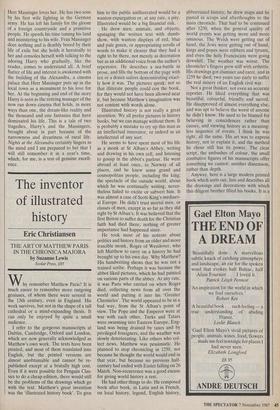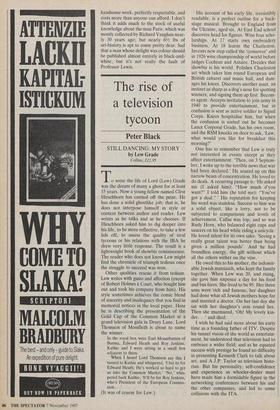The inventor of illustrated history
Eric Christiansen
THE ART OF MATTHEW PARIS IN THE CHRONICA MAJORA by Suzanne Lewis
Scolar Press, f85
Why remember Matthew Paris? It is much easier to remember more outgoing geniuses, of whom there were several in the 13th century, even in England. His work survives, but not in the shape of a tall cathedral or a mind-expanding thesis. It can only be enjoyed by quite a small audience.
I refer to the gorgeous manuscripts at Dublin, Cambridge, Oxford and London, which are now generally acknowledged as Matthew's own work. The texts have been printed, and most of them translated into English, but the printed versions are almost unobtainable and cannot be re- published except at a brutally high cost. Even if it were possible for Penguin Clas- sics to do a cheap edition, there would still be the problems of the drawings which go with the text. Matthew's great invention was the 'illustrated history book'. To give him to the public unillustrated would be a wanton expurgation or, at any rate, a pity. Illustrated would be a big financial risk.
He drew men, animals, and objects, upstaging the written text with dumb- show, with wanton displays of red, blue and pale green, or appropriating scrolls of words to make it clearer that they had a right to be there, not merely as decoration but as an additional voice from the author's repertoire. He describes a sea-battle in prose, and fills the bottom of the page with ten or a dozen sailors demonstrating exact- ly how it was. The pictures speak; not so that illiterate people could con the book, for they would not have been allowed near it, but because Matthew's imagination was not content with words alone.
Illustrated history is not really a great invention. We all prefer pictures in history books, but we can manage without them. It is probably a mistake to cry up this man as an intellectual innovator, or indeed as an intellectual of any sort.
He seems to have spent most of his life as a monk at St Alban's Abbey, writing and drawing in his own cell, and listening to gossip in the abbot's parlour. He went abroad at least once, to Norway of all places, and he knew some grand and cosmopolitan people, including the king; the spectacle of the outside world, about which he was continually writing, never- theless failed to excite or subvert him. It was almost a case of Scott-King's mediaev- al Europe. He didn't trust mortal men, or classes of men, except in so far as they did right by St Alban's. It was believed that the first Briton to suffer death for the Christian faith had died there; nothing of greater importance had happened since.
He took most of his notions about politics and history from an older and more irascible monk, Roger of Wendover, who left Matthew to carry on a history he had brought up to his own day. Why Matthew? His handwriting shows that he was not a trained scribe. Perhaps it was because the abbot liked pictures, which he had painted on various parts of the abbey. At any rate, it was Paris who carried on when Roger died, collecting news from all over the world and putting it into his 'Greater Chronicles'. The world appeared to be in a bad way, from the St Alban's point of view. The Pope and the Emperor were at war with each other, Turks and Tatars were swarming into Eastern Europe, Eng- land was being drained by taxes and by privileged foreigners, and the weather was slowly deteriorating. Like others who col- lect news, Matthew was pessimistic. He planned to stop chronicling in 1250, not because he thought the world would end in that year, but because no previous half- century had ended with Easter falling on 26 March. Non-recurrence was a good excuse for giving world history a rest.
He had other things to do. He composed book after book, in Latin and in French, on local history, legend, English history, abbreviated history; he drew maps and he pasted in scraps and afterthoughts to the main chronicle. That had to be continued after 1250, when the general quality of world events was getting more and more ominous. The Welsh were getting out of hand, the Jews were getting out of hand, kings and popes were robbers and tyrants, and even the holy Franciscans were going downhill. The weather was worse. The chronicler's fingers grew stiff with arthritis. His drawings got clumsier and rarer, and in 1259 he died; two years too early to suffer the real misery of an English civil war.
Not a great thinker, not even an accurate reporter. He liked everything that was beautiful, colourful, friendly and sacred. He disapproved of almost everything else, and was apt to believe the worst of anyone he didn't know. He used to be blamed for believing in coincidences rather than causes, and viewing history as a meaning- less sequence of events. I think he was right, all the same. His art was to express history, not to explain it, and the method he chose still has its power. The clear script, the ambushes of colour, the small combative figures of his manuscripts offer something we cannot: another dimension, rather than depth.
Anyway, here is a large modern printed book which sorts out, lists and describes all the drawings and decorations with which this diligent brother filled his books. It is a handsome work, perfectly respectable, and costs more than anyone can afford. I don't think it adds much to the • stock of useful knowledge about the man Paris, which was mostly collected by Richard Vaughan near- ly 30 years ago; but nearly 61/2 lbs of art-history is apt to come pretty dear. Sad that a man whose delight was colour should be published almost entirely in black-and- white, but it's not really the fault of Professor Lewis.



































































 Previous page
Previous page